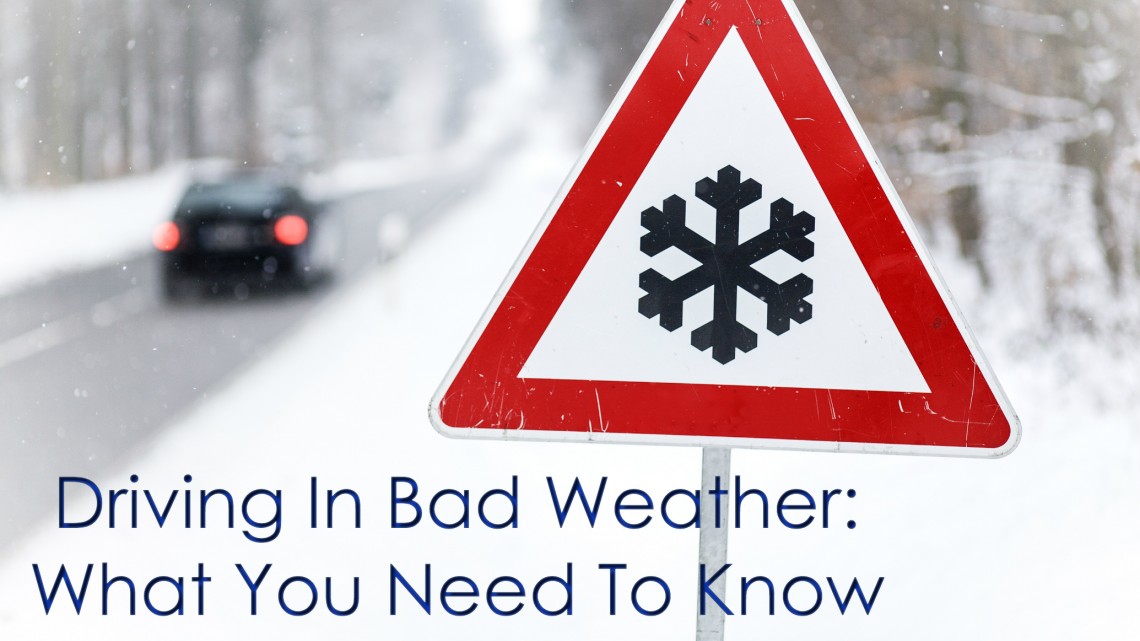Rain, snow, wind.
All of these plus more have a tremendous impact on the roads traveled by millions of Americans daily.
Data collected from the US Department of Transportation’s Federal Highway Administration (FHWA) states that there are over 5,870,000 vehicle crashes each year. 23 percent of those crashes (almost 1,312,000) are weather-related.
Adverse weather defines elements such as rain, sleet, snow, fog, blowing snow/sand/debris, or slick pavement (wet pavement, snowy-slushy pavement or icy pavement). On average, 6,250 people are killed and over 480,000 people are injured in weather-related crashes each year.
74 percent of weather-related crashes happen on wet pavement, and 46 percent during rainfall. 17 percent of crashes occur in snow or sleet, 12 percent occur on icy pavement, and 14 percent on snowy or slushy pavement. Only 3 percent happen in the presence of fog.
According to the FHWA, inclement weather maintenance accounts for nearly 20 percent of state Department of Transportation (DOT) budgets. Each year, state and local agencies spend more than $2.3 billion on snow and ice control operations.
Below are tips and information for driving in inclement weather, categorized by the elements.
Low Visibility
Components such as fog, heavy precipitation, wind-blown snow, dust and smoke all affect your visibility distance.
Over 38,700 automobile crashes occur in fog, according to the FHWA. Over 600 people are killed and more than 16,300 people are injured in these types of crashes each year.
Tips:
- Don’t speed up. Glance at your speedometer every now and then and drive at reasonable speed.
- Stay visible to others. Always keep your headlights on to alert other drivers you are there. If your car is equipped with fog lights, use those too.
- Do NOT use your high beams. Your high beam lights reflect off of the water vapor and decrease your visibility.
- Stay in your lane. Watch the lines of the road as you drive, as to ensure you stay in your lane.
- Don’t tailgate. Do not follow another car too closely, as this may cause massive pileups.
- Pull over if necessary. If you need to stop, try to get as far off the road as possible. A driveway, parking lot, rest area, side street, or any other place where you can get away from heavy traffic flow is ideal. Be sure turn your lights off. Other drivers on the road might rear end you thinking you are still driving.
Rain and Flooding
Each year, 75 percent of weather-related vehicle crashes occur on wet pavement and 47 percent happen during rainfall.
Nearly 5,700 people are killed and more than 544,700 people are injured in crashes on wet pavement annually. Over 3,400 people are killed and over 357,300 people are injured in crashes during rainfall.
Inland flooding, which usually follows a tropical storm or hurricane, has been the greatest source of fatalities and has caused the most damage to roadway infrastructure.
Tips:
- Pay attention to barricades. Don’t ignore them or drive past them.
- Do not drive through standing water. The average automobile can be swept off the road in one foot of moving water, and roads covered by water are prone to collapse. Attempting to drive through water also may stall your engine, potentially causing irreparable damage.
- Give yourself plenty of time. Plan for a commute twice as long when the weather is bad and expect heavier than normal traffic.
- Stay alert. Refrain from talking on the phone, texting, eating, or any other distractions that could impede your driving ability.
- Use caution after dry spells. Roads are often most dangerous after a long, dry spell. Oil, grease and other pollutants tend to build up during a period without rain, and when they mix with rainwater, the result is a very slick road.
Snow and Ice
Snow and ice greatly impact drivers, reducing visibility. They also reduce pavement friction and vehicle maneuverability, causing slower speeds, reduced roadway capacity and increased crash risk.
Over 70 percent of the nation’s roads are located in snowy regions, which receive more than five inches of average snowfall annually. About 70 percent of the U.S. population lives in these snowy regions.
Every year, 24 percent of weather-related vehicle crashes occur on snow, slushy or icy pavement. 15 percent happen during snowfall or sleet.
Over 1300 people are killed and more than 116,800 people are injured in vehicle crashes on snowy, slushy or icy pavement. Every year, nearly 900 people are killed and nearly 76,000 people are injured in vehicle crashes during snowfall or sleet.
Tips:
- Stay off the road. Avoid driving if possible to avoid getting stuck overnight or having an accident.
- Use your headlights. Avoid fog lamps. Only use these when the
- Keep your distance. It can take as much as ten times as long to stop on an icy road as it does on a dry one. A good rule of thumb is that you should be around 20 seconds behind the car in front of you if the road is icy.
- Drive smoothly and gently. Use all of your car controls – such as steering, throttle and brakes – slowly and progressively. Abrupt changes in the car’s attitude will cause the tires to lose what little grip on the road’s surface they have. Avoid sudden maneuvers that might unbalance your car, such as sharp steering or braking.
Hurricanes
Hurricanes and tropical storms are accompanied by heavy rain and high winds to coastal areas, often causing inland flooding. Hurricane evacuation activities can have significant impacts on traffic.
According to the National Hurricane Center, more than half of hurricane deaths in the last 30 years resulted from inland flooding. Of those deaths, one in four people drowned in cars.
You should avoid driving through a hurricane at all costs. But if you are already on the road, heed the following guidelines.
Tips:
- Stay in your car. Try to find shelter, whether it be an overpass or parking garage.
- Avoid driving through standing water. People often underestimate the depth of water, which can hide dangers, damage your engine, or even carry your vehicle away.
- Look out for wires. The storm may have knocked down several during its course, so make sure you don’t get stuck driving through them.
- Be aware of your surroundings. Larger vehicles such as trailers, big trucks and buses are more vulnerable when driving in high winds, so maintain more distance than you normally would from these vehicles.
- Don’t use cruise control. This can cause your vehicle to accelerate during a hydroplane. If you hydroplane, let off the gas slowly and steer straight until your tires find the road again. Don’t slam on the brakes or turn the steering wheel.
High Winds
High winds reduce roadway capacity by obstructing lanes or roads with drifting snow and wind-blown debris, such as tree limbs. Wind-blown snow, dust and smoke can impact mobility by reducing visibility distance. High winds can also impact the stability of high-profile vehicles such as RVs, campers, trucks or buses.
Tips:
- Stay alert. Drive with both hands on the wheel and turn on headlights if needed to account for lower visibility created by blowing dust, sand, snow or rain.
- Slow down. The faster you’re traveling, the further off-course you’re likely to drift in a sudden gust before you get your vehicle back under control.
- Keep your distance. High-sided vehicles and caravans are most affected by high winds, but sudden gusts can blow any vehicle off course. Keep your distance especially around cyclists and motorcyclists.
- Watch for obstructions. Some trees or branches will fall when winds are high. Hitting debris like this at a high speed could be fatal, so it’s integral to keep your speed down and drive with great care.





No Comment